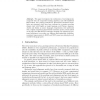Free Online Productivity Tools
i2Speak
i2Symbol
i2OCR
iTex2Img
iWeb2Print
iWeb2Shot
i2Type
iPdf2Split
iPdf2Merge
i2Bopomofo
i2Arabic
i2Style
i2Image
i2PDF
iLatex2Rtf
Sci2ools
FINTAL
2006
2006
Improving Phrase-Based Statistical Translation Through Combination of Word Alignments
This paper investigates the combination of word-alignments computed with the competitive linking algorithm and well-established IBM models. New training methods for phrase-based statistical translation are proposed, which have been evaluated on a popular traveling domain task, with English as target language, and Chinese, Japanese, Arabic and Italian as source languages. Experiments were performed with a highly competitive phrase-based translation system, which ranked at the top in the 2005 IWSLT evaluation campaign. By applying the proposed techniques, even under very different data-sparseness conditions, consistent improvements in BLEU and NIST scores were obtained on all considered language pairs.
Competitive Linking Algorithm | Competitive Phrase-based Translation | FINTAL 2006 | Natural Language Processing | Phrase-based Statistical Translation |
| Added | 22 Aug 2010 |
| Updated | 22 Aug 2010 |
| Type | Conference |
| Year | 2006 |
| Where | FINTAL |
| Authors | Boxing Chen, Marcello Federico |
Comments (0)

